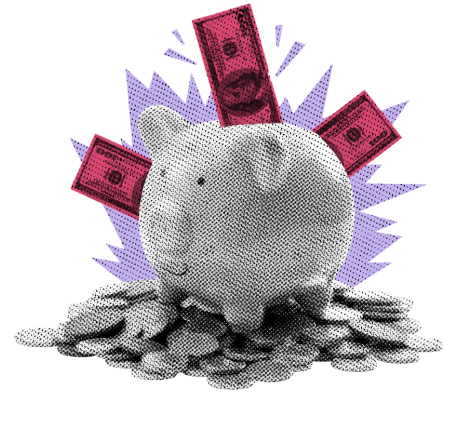
Stocks declined on Friday as the Trump trade hangover kicked in, made more painful from Powell’s prior day comments. Retail Sales for October came in with another beat, but closer inspection reveals that it was Auto sales that drove the bigger-than-expected monthly increase; in either case, consumers seem willing to spend, spend, SPEND.
More monetary tightening. “Wait, what,” you exclaim! “I thought we were in a loosening cycle, not in a tightening one,” you add. Let’s start with the policymakers who are paid to ply the brakes and accelerator of the US economy, the Federal Reserve. The ever late to the party Central Bank is charged with keeping the labor market strong while simultaneously keeping inflation low, its, so-called "dual mandate.” Back in 2021, inflation was screaming to be dealt with. I happen to have a degree in Economics, but you didn’t need one to know that the Fed needed, in some way, to deal with the mounting threat. Sure, the FOMC ultimately arrived at the party, but far too late to save the sofa and carpet from being damaged. Inflation had its fingers firmly on the throat of the economy when policymakers even managed to invent a new word to describe inflation and justify why they decided to wait and see. Ultimately, they came, they saw, they realized that the mess might have been minimized, and they – er, reacted with some out-of-character aggressive tightening moves that sent equity markets into a bit of a painful cooling off period (that’s a nice way to say, losses 😉).
Ok, so we survived, and inflation ultimately turned around, for the most part. Goods price growth came back to earth, food price inflation eased a bit but remained noticeably just outside the comfort zone of most consumers, and services inflation refused to relent. Specifically, in housing and healthcare. Unfortunately, the Fed’s Jedi mind tricks don’t work on healthcare inflation or housing inflation, so the Fed was left with nothing to do other than hope that ultimately the natural forces of economics would fix the problem. Healthcare, well you can expect me to write an awful lot about that sector in the next 18-months as Trump 2.0 takes over Washington’s corner offices once again, with its sites on the sector. But for now, assume that Healthcare inflation will continue despite whatever the central bankers do.
Housing is an altogether different problem. I have written an awful lot about how higher interest rates actually CAUSE higher inflation in the sector. Understanding this relationship, too, should not require a degree in economics. Do you rent? It is highly likely that your landlord has financed your rental property, leaving their profitability at the mercy of prevailing interest rates. Higher interest rates means higher costs to your landlord. How do landlords remain profitable with rising costs? Well, they certainly won’t cut your rent. Do you want to buy a home but realize just how few homes are on the market, and the ones that are astronomically priced – or in a flood zone? That’s because the market is short by, what some estimate, some 8 million units. Real estate developers rely heavily on finance, which not only puts their margins under pressure, but may even cause a developer to decline to build, thus exacerbating the supply problem.
Okay, so the Fed can simply just lower interest rates and fix all these issues, right? Let’s take a step back and remember that the Fed can be cutting rates but still restricting growth. Over the past 18 months, the Fed, in typical fashion watched the unemployment rate tick up and economic growth slow before it very slowly scooched its rearend to the edge of its seat and publicly took notice. It then watched with its hand just above the easing lever as the ship approached the deadly shoal at racing speed. The bankers were now attempting the same maneuver that landed them late to the party in 2021. A perfectly timed landing. Finally, a few months back, the Fed decided to act – er react once again with a 50 basis-point cut out of concern that it may be a bit late. Such a move was sure to stop a potential economic calamity in its tracks. Mortgage rates were already declining and developers, REITS, and PE players lined up and prepared to bring the real estate industry back to life. But something quite odd happened. In what seems like a minute after the Fed made its first interest rate cut since 2020, mortgage rates began climbing, following 10-year Treasury note yields. What exactly was going on?
I am going to say this for maybe the 100th time in as many months, but I must. THE FED DOES NOT CONTROL LONGER MATURITY YIELDS ON WHICH MORTGAGE RATES ARE BASED. Please, if you remember anything, remember that. If you don’t believe me, have a look at this chart.

The chart is a mess, because the situation is, indeed, a mess. Yields on 10-year Treasury Notes have climbed since the Fed came in with its first 50 basis-point cut, and with it 30-year Mortgage rates. OUCH! What caused those yields to climb? Well, initially bond traders believing that the economy was picking up pace which would ultimately bring back inflation. Go ahead, read it again. You see the economy was beginning to look stronger just as the Fed decided to deliver a super-sized rate cut. And, by the way, bond traders control the back end of the yield curve, not the Fed. Bond buyers demand higher yields to compensate for expected, future inflation. Can you see the mess starting to accumulate? It was only a matter of time before someone spilled wine on the couch. Things would only get worse as the party went on.
This was an election year, and it was the season of giving, as I like to call it. Both candidates were in the final throws, which meant that they were promising everything to everyone who was registered to vote. All those incentives cost money, and when that butcher bill arrives, the Treasury will have to borrow more money, increase the national debt, to pay for those election promises. Bond traders, though boring, are not reactive like the central bank, and they decided to get ahead of the potential swelling of the deficit by pushing yields higher. As mentioned, both Harris’ and Trump’s election promises would come with a cost, though Trump’s appeared to be larger. Regardless of whose voodoo math you follow, the US was poised to go on a spending spree on credit, and when Trump came up the winner, bond traders leapt into action… instantly.
When it became clear that President Trump would return to Pennsylvania Avenue accompanied by a Republican Senate and a now-Republican House, his chances of realizing those promises became more probable. Yield on 10-year Notes gained more tailwind easily reaching yields not seen since early summer. And mortgage rates followed. What a mess. The Fed is trying to ease monetary conditions and bond vigilantes are tightening monetary conditions. That is bad enough, but last week, Chairman Powell threw into question the Fed’s intentions in 2025, hinting that the Bankers are in no rush to cut rates in a hurry, choosing to fall back on its almost always late reactionary behaviors that didn’t work in the past. Powell’s words themselves served as monetary tightening. Stocks slipped in response to Powell’s admission. Did you know that there is a wealth effect from a bull market? Sure, you do. You know that you are more willing to spend more money when your portfolio is worth more. My regular followers also know that even people who don’t own stocks consume more when they hear that stocks are on the climb.
What we are left with folks, is a situation where the Fed’s heart is hardening, bond vigilantes are literally tightening monetary conditions, and a shaky equity market is too causing consumption drag. Don’t be surprised to hear that deals in interest rate sensitive sectors that were being worked on just a few weeks ago are now being put on ice. Were you considering making a big purchase just a few weeks ago and now deciding to wait-and-see? How about buying a house? Were you getting excited to take advantage of lower mortgage rates that were sure to come? If you really want to know the answers to these questions, I suggest you befriend a bond trader. They may not be as flamboyant as central bankers, but knowing what they think might be more useful to you when deciding what to do with your stocks – and big-ticket purchases.
FRIDAY’S MARKETS

NEXT UP
- NAHB Housing Market Index (November) is probably unchanged from October’s 43 print.
- Chicago Fed Austan Goolsbee will speak today.
- Later this week. Earnings season winds down, but we still have some really important releases, namely NVIDIA and big box retailers, amongst others. In the econ department, we will get more housing numbers, regional Fed reports, Leading Economic Index, S&P Global Flash PMIs, and University of Michigan Sentiment. Download the attached economic and earnings calendars for times and details.
DOWNLOAD MY DAILY CHARTBOOK HERE 📊
.png)

